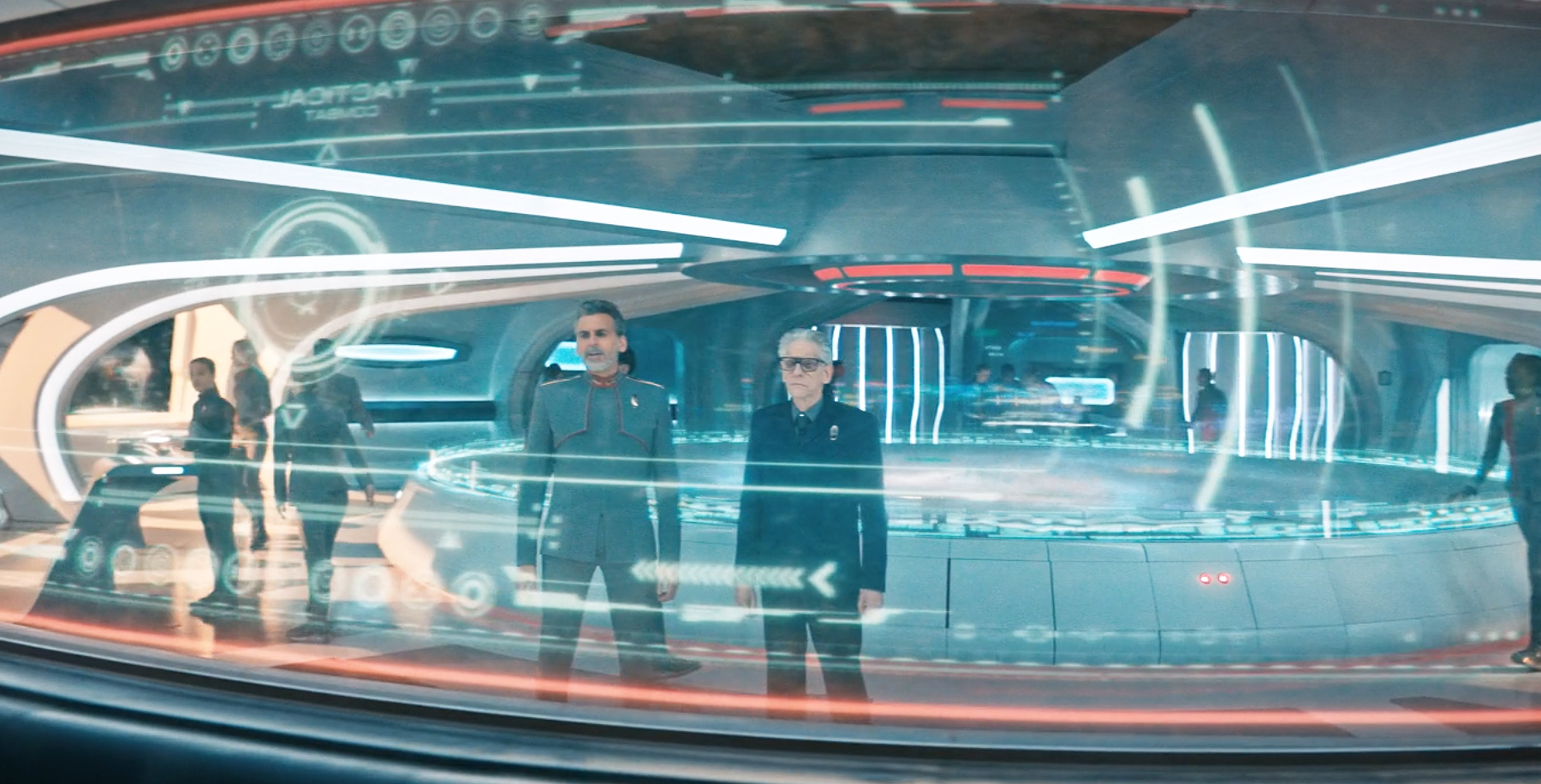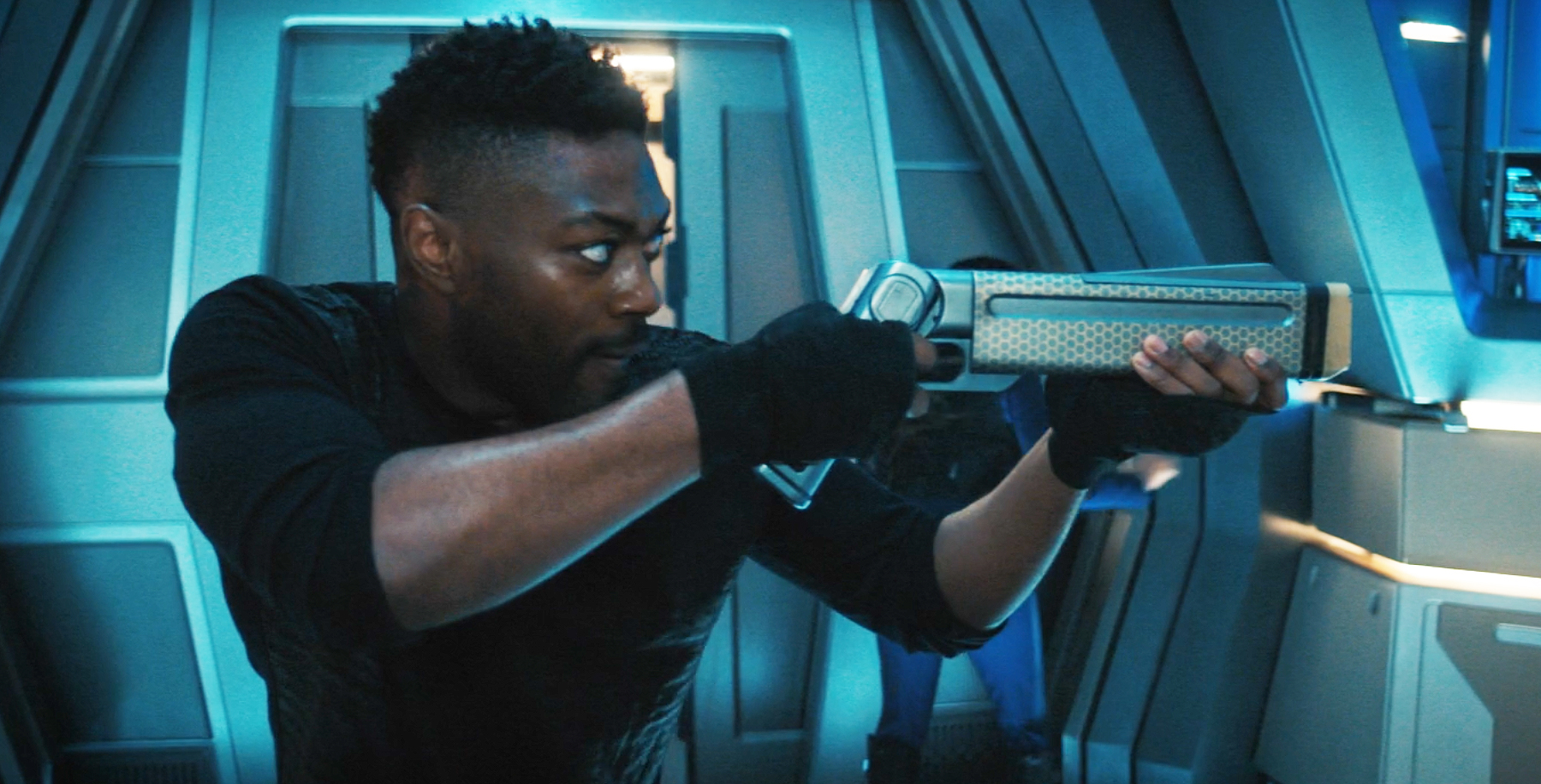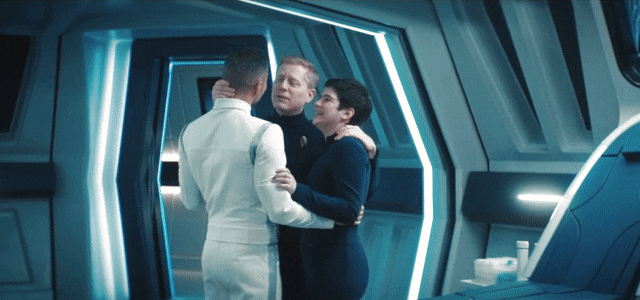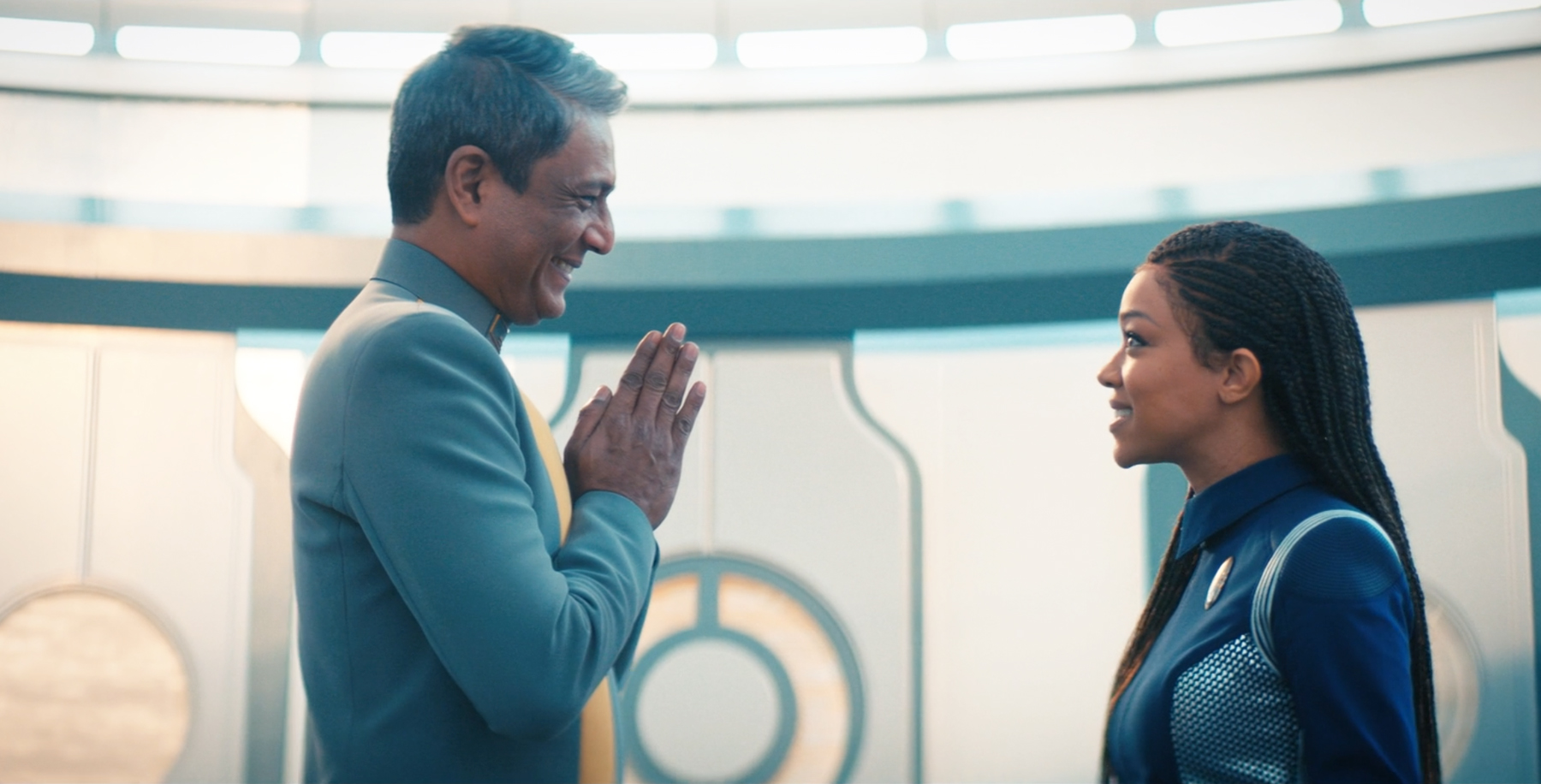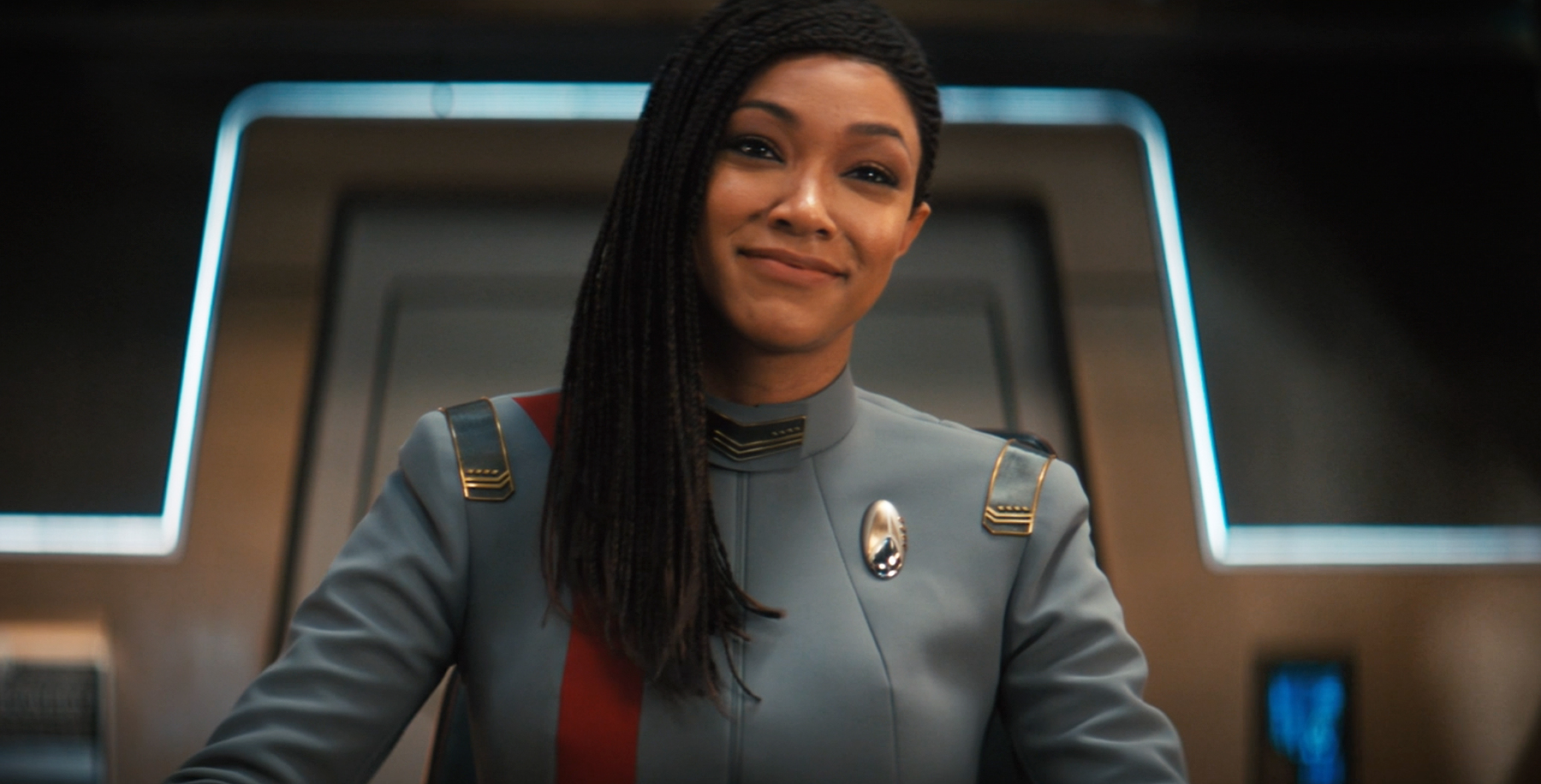'Star Trek: Discovery' finishes season 3 with a mediocre finale
Dilithium now has a sub-space component..?! What does that even mean?
According to Starfleet medical research, spoilers can cause severe skin irritations.
We've said in the past that the most consistent thing with the third season of "Star Trek: Discovery" on CBS All Access is how inconsistent it is and its season finale doesn't do anything to alter our opinion. Looking back at all 13 episodes, we've seen some glimpses of absolute genius, we've seen some abhorrently lazy writing and we've seen just about everything in between. With the last two live-action "Star Trek" shows giving us lame season finales, there was quite a lot riding on this one, and while it's better than its predecessors, Discover's season three ender is not without its faults … and sadly, there are quite a lot of those.
When you do look back at the past 13 episodes, it's very hard to detect much sense of underlying continuity; characters radically change from one installment to the next, the style of production changes and the pace is uneven. Of course, it's good that different writers and directors participate and that should be encouraged, but perhaps a Style Guide is in order. After all, different writers contribute to the same publications and the aim is to ensure they retain a similar tone and remain within the established structure of the newspaper or magazine, thus most have a style guide of one sort or another.
It feels like a large group of writers got split up into 13 separate smaller groups and then all sent to different rooms to each work on their respective episodes with only the most minimal of guidelines, and weren't allowed to get together and share their thoughts or ideas. This is almost certainly not what happened, but it cannot be denied that's how it feels.
The first thing to note is that, at at 1 hour and 2 minutes, this episode is longer than any other installment of "Discovery." But before long, you'll realize some of that gets taken up with the season recap (2½ minutes) and then later, as the episode unfolds, you'll see that much of that runtime is filled with So Many Face Shots of the bridge crew, so many. Happy ones, sad ones, dying ones, still alive ones, proud ones, angry ones and even suffocating ones.
We begin back on the KSF Khi'eth, which itself is on the dilithium planet in the Verubin nebula. Dr. Culber (Wilson Cruz) is gazing at the gormagander, a sentient cosmozoan species, which have a very similar production design and undulating motion to the giant space orchids we saw in "Picard." Saru (Doug Jones) is still trying to talk some sense to Su'Kal (Bill Irwin). It's great to Jones being able to act in the flesh — so to speak — and utilize more of his expressions since many of the roles he is well known for, like "Hellboy" and "The Shape of Water" required him to wear heavy prosthetic make-up.
Adira (Blu del Barrio) shows up bringing radiation meds and the holo-simulation has them portrayed as Xahean, like Queen Me Hani Ika Hali Ka Po (Yadira Guevara-Prip) we last saw in "Such Sweet Sorrow" (S02, E13). The holo-simulation has also brought Gray (Ian Alexander) into real world existence, as a Vulcan. Quite why the computer on the Khi'eth chose to represent just him and none of the other five Trills isn't adequately explored. A missed opportunity here perhaps.
Inside Starfleet HQ, Admiral Vance (Oded Fehr) gives orders that every starship open fire on Discovery while the Viridian, Osyraa's (Janet Kidder) ship is blasting the shield from outside. It seems that every "Star Trek" finale incorporates a large-scale space fight; it's not clear if the writers on "Star Trek" are aware that the story arc can include a large-scale space fight at any point in the season and an equivalent amount of tension can be achieved through a number of dramatic methods. It would certainly make a change at this stage. (Also, this is how you write space battles.) Stamets seems to have totally lost his cool after Burnham saved his life last week and pleads with Vance to go back to Discovery to use the spore drive to rescue Culber. With little lead, he's suddenly been written as a monumental tool, believing that he's the only one in danger of losing a loved one.
Breaking space news, the latest updates on rocket launches, skywatching events and more!
Interestingly, the fleet from Ni'var arrives to assist and Burnham's mum, Gabrielle, is a no-show, which makes the whole emotional comms call from the Nakatomi building Jeffries tube in last week's episode somewhat less important to the plot of "Discovery" and more important in keeping with the influence of "Die Hard."
On the Discovery, Michael Burnham (Sonequa Martin-Green) and Book (David Ajala) are bought to the bridge and then almost immediately taken away again, to sickbay to be tortured. The bridge crew, led by Ensign Tilly (Mary Wiseman) are attempting to reach the bridge, blasting Osyraa's Regulators with the help of the those little DOT-23 droids that are now being controlled by the sphere data/Zora. However, Osyraa closes all the deck doors and begins bleeding the atmosphere into space.
The shields collapse on Federation HQ and Osyraa threatens some sort of chemical attack … in space … where it's necessary for ships to be airtight. Vance orders the Ni'var fleet to hold back. Discovery jumps to warp, closely followed by the Viridian and the Ni'var fleet. Roll opening credits.
On the Khi'eth holodeck, Saru is slowly making progress convincing Su'Kal that he is actually Kelpien as they chat over a nice, hot bowl of Sàì-núù-lem. Culber explains that he suspects Su'Kal is a polyploid. "That's when a normal chromosomal separation is disrupted in utero. It can cause an individual's genes to be affected by their environment," he says. Su'Kal is genetically connected to dilithium; his genes have mutated to allow his body to interact with dilithium in unique ways. Adira adds to his dubious deduction by informing us matter-of-factly that dilithium has a subspace component, consequently Su'Kal would have a genetic connection to subspace as well. What..?? A subspace component? What does that even mean?
They conclude that the shockwave that hit the Discovery in last week's episode was a result of Su'Kal freaking out and consequently whatever frightened him 125 years ago, caused a much bigger shockwave — the Burn. And we are meant to believe that despite being afraid of his own shadow, nothing in-between then and now has caused Su'Kal to have another panic attack and thus cause another burn. But that's OK, we'll be generous and let that one go … as well. Gray goes beyond the holo-simulation without suffering any issue with being out of range of the hard-light emitters and determines that the ship is falling apart and the shields won't hold up much longer. In fact, Gray isn't really used for much more than that, in essence sticking his nose out of the window for a quick look-see.
On Discovery, Osyraa together with a spectacularly underused Zareh (Jake Weber) urges a reluctant Aurellio (Kenneth Mitchell) to begin torturing Book. There's a fun throwaway remark about it being a "no-win situation" for Burnham and it's nice to see "Star Trek" actually incorporate the occasional nod to its own franchise for a change. Book isn't going to easily give up the information on how to safely navigate the nebula to get to the dilithium planet, so Burnham pleads with Osyraa to let her try and convince him and thus stop the torture.
In the blink of an eye, Burnham disables one Regulator, activates a "quarantine shield" and blasts another. Whilst otherwise being a really nice idea, weirdly, the quarantine shield encompasses the doorway so they are able to make their escape while Osyraa and Zareh look helplessly on. Elsewhere on Discovery, the bridge crew — while still slowly suffocating — considers ways to reset the ship's computer, which they deem cannot be done unless they were physically at the core.
Using a stolen Regulator comms badge, Burnham accesses the shipside PA system and gives Tilly a coded message on how to disable the ship and presumably make it drop out of warp. (Couldn't Tilly have given instructions to the sphere data/Zora by way of a DOT-23 droid to restart the core?) Since … er, the magnetic fields of the ship's nacelles are affected by extreme heat, setting off a thermonuclear bomb inbetween the superconductors holding the nacelles in place would cause the ship to drop out of warp speed. And a lot more besides we'd wager.
At this point, the writers had to come up with a plausible reason why a DOT-23 droid couldn't just be sent to do this, so Lt. Gen Rhys (Patrick Kwok-Choon) helpfully explains that "the magnetic field could destroy the DOT before they've even set the bomb," so there you go. However, that's not say a DOT couldn't carry a canister of oxygen — or go and fetch more, but that possibility isn't explored and nor is the reason why there are so few oxygen breathers actually available.
Burnham and Book hack their way into a turbolift…and we arrive at my biggest criticism of this episode — and quite possibly of "Star Trek: Discovery" in general — coming in only just ahead of the use of the visual effect known as "smart matter" or sometimes called "the 'Transformer' effect" is…the utterly absurd portrayal of the seemingly immense space between the USS Discovery's decks. First seen in the second season premiere episode "Brother" the producers are trying to convince us that there is a TARDIS-like construction to the Discovery, with huge, huge open spaces between decks and a turbolift ride that looks like it's part of Space Mountain. There's just no reasonable explanation; this is simply not how starships would be built, ever.
While the USS Enterprise-D is actually written as being insanely big, there still aren't unfathomably enormous areas of space between each deck; at most there would probably be a crawl space, EPS conduit or a Jeffries tube and the turbolifts have dedicated shafts. Plus of course the USS Discovery was built over 100 years before the USS Enterprise-D.
It doesn't add anything of value to the show, in fact, it's quite the opposite: it drives a wedge between the viewer and the episode, preventing a full, immersive experience, which is what the viewer wants and what the writer/producer/director wants you to have. If you've ever read "Star Trek: The Making of the TV Series" you'll know through the incredible inclusion of so many memos (that's how progress was made in the 1960s) between Gene Roddenberry and the production team just how much attention was paid to every detail wherever possible to accurately portray life on a starship in the 23rd century. And when a live-action "Star Trek" television show made 55 years later is not as believable, you've got some fundamental problems.
An intense firefight breaks out as Regulators swarm their position and sadly all the effort that went into that, like the choreography and visual effects, is lost as its hard to get past the sheer ridiculousness of the ship's interior. Burnham makes her way to the data core while Book dispenses with Zareh, who falls out of an open turbolift and plummets hundreds of feet to his ultimate death below. Honestly, there's so much space inbetween the decks of Discovery he could've opened a parachute and he'd have been fine.
Waiting for Burnham inside the data core are a few token Regulators and Osyraa herself. An interesting hand-to-hand fight breaks between the two and the concept that the blaster rifles are pump-action is introduced, which is cool right up to the point where they somehow blast each other at point blank range simultaneously and they just get thrown backwards by an energy burst, 'cause that's weird.
All the while Lieutenant Owosekun (Oyin Oladejo) is getting her biggest break out moment in the show since "New Eden" (S02, E02), the second season's best episode. She's been tasked with delivering the thermonuclear device into the nacelle coupling superconductor thingamajig, but her air is running out. So…er, how come if there's so much space in-between decks and neither Burnham or Book were suffering from suffocation, the air from this weird, interdeck dimension doesn't just fill out all the other areas of the ship? It's not like turbolifts doors are airtight.
Believing she's going to die, a DOT-23 droid arrives and offers her a helping hand. So…um, it hasn't been destroyed by the magnetic field and even if it's suffering irreparable damage, it still seems to be functional enough to have been able to plant the device itself. So, forgetting about that too…it detonates and damages the nacelle coupling, causing the Discovery to drop out of warp. The droid has heroically dragged Owosekun to safety from a thermonuclear blast, but has suffered fatal damage itself, as you'd probably imagine. She gets all upset but seems to have forgotten the many other DOT-23 droids that got unceremoniously blown to pieces along the way.
Then in a really weird moment, Osyraa tries to shove Burnham into…what we can only assume is meant to be the actual data core. Like something straight out of "Superman III" it begins to envelope her and we're not entirely sure how that would be fatal and in fact it isn't because she blasts Osyraa with two shots to the chest and manages to pull herself out. Having regained control of the Discovery she restores atmosphere to all decks because no one thought to just get into a turbolift, open the door and breathe normally.
The Viridian, however, has managed to ensnare the Discovery in just a matter of seconds of it dropping out of warp. Apparently, the Ni'var fleet are also there, but they've so far done very little to help. Burnham instructs everyone to the bridge where Tilly happily relinquishes her command. The only way of the Viridian is to eject and detonate the warp core and use Book's natural empathic relationship with nature to navigate the mycelial network. Aurellio has come full circle and realized the error of Osyraa's ways and is assisting with the spore jump. The way that the warp core bounces around the ejection tube on its way out was a nice touch, something a little different.
On the dilithium planet, with the Khi'eth disintegrating around them, Su'Kal plucks up the courage to step beyond the holo-simulation and in probably the best scene in this episode, we learn about his backstory and watch him learn the fate of his family. Despite having deduced this much earlier, we also see that the burn was caused as a result of his emotional reaction to the death of his mother. However, it's unclear when she actually placed him in the holo-simulation, presumably it was before she died…so how did he witness her death? Programming the ship's computer to begin the simulation after she died seems like a poorly thought out plan.
The Discovery arrives just in time and beams everyone off the Khi'eth, which naturally disintegrates seconds later. Everybody's happy — except Stamets — and being away from all that dilithium means Su'Kal isn't going to accidently murder millions of innocent people again. In a nice touch, we get to see former Federation liaison and newly commissioned Communications Chief Aditya Sahil (Adil Hussain) once again, but this time he's proudly wearing his Starfleet uniform.
Saru decides to remain on Kaminar and Burnham gets promoted to captain. Oh yes. The producers of "Star Trek: Discovery" have finally worked out that a show that focuses on someone other than the ship's captain only has a limited lifespan. Burnham does look good in the new uniform — and in the center seat — and quite frankly, this should've been done long ago, rather than mucking about with "guest captains" for three seasons. Finally, like an awful slogan from a 70s airline commercial meets Napoleonic War era Royal Navy, Burnham utters the best catchphrase an overpaid team of television writers could come up with…and it's cringeworthy.
One of the reasons why I love "Star Trek" is because it offers a world to escape into, but to be able to escape in it, it has to be believable. Like the real world, it needs basic rules — you know, like the rules of physics and chemistry — to make it convincing and consistent. And prior to "Star Trek: Discovery" most of those were maintained. But so often in this show — and this episode is a textbook example — those rules and therefore uniformity and enjoyment — are just tossed out of the airlock.
Despite everything that's been said here, this episode was still better than the Season 1 finale of "Picard" and the second season finale of "Discovery."
One of the major themes of this season was supposed to be the change in Burnham, ultimately preparing her for the role of captain. The writers have tried to convey that a tweak was needed in her original personality; a sprinkling of unstifled resourcefulness, if you will, that came from her long 12 month sabbatical with Book, but far too much is shown to have happened in too short a period of time.
First she gets reprimanded by Vance and demoted by Saru. Then only a few weeks ago, Burnham was telling her mum that she didn't want to be in Starfleet anymore. Then, after a 60-second pep talk from Georgiou (Michelle Yeoh) she has a change of mind of such an extreme nature that she even began to question Saru's ability to command. And now this is stretching believability and credibility. And what about poor Saru?
Remember at the end of the second season when everyone wanted to see him take command? He seems to have got the short end of the stick. His journey has been just as challenging for him and now he's relegated by the writers to counseling work on Kaminar, which makes us wonder if perhaps a decision by Doug Jones is the reason behind this.
Does he have new commitments elsewhere? He is listed on IMDb as being part of the cast for a new start-up sci-fi called "Space Command" that began life as a crowd-funded project, but now boasts quite the old school sci-fi cast, including Bruce Boxleitner, Mira Furlan and Bill Mumy, all from "Babylon 5" together with the one and only Robert Picardo. Has a major distributor picked up this show? We will of course keep you posted as we find out more.
Rating: 6½ out of 10.
Getting down with a Deltan ✓
- Like how other factions of the Emerald Chain chose peace post-Osyraa.
- At least this space battle didn't feature shuttlecraft and drones flying about.
- The crew finally got around to changing their uniforms.
- Nice to see both Kovich and Aditya Sahil, although we would've liked more.
- The crew finally got around to updating their uniforms.
Hooking up with a Horta ✗
- Why can't big space battles happen as part of the mid-season plot?
- So. Much. Inconsistency.
- Stamets has suddenly been written in a way that's so out of character. Might have been nice to hear how Su'Kal got past his Vahar'ai.
- "Let's fly" is…cringeworthy.
CBS All Access is the home of "Star Trek: Picard," "Star Trek: Discovery," "Star Trek: Lower Decks" and a host of other original and archival CBS television shows. Subscriptions start at $5.99 a month. You can try CBS All Access for a week free here.
Follow Scott Snowden on Twitter @lorumipsum. Follow us on Twitter @Spacedotcom and on Facebook.

When Scott's application to the NASA astronaut training program was turned down, he was naturally upset...as any 6-year-old boy would be. He chose instead to write as much as he possibly could about science, technology and space exploration. He graduated from The University of Coventry and received his training on Fleet Street in London. He still hopes to be the first journalist in space.

